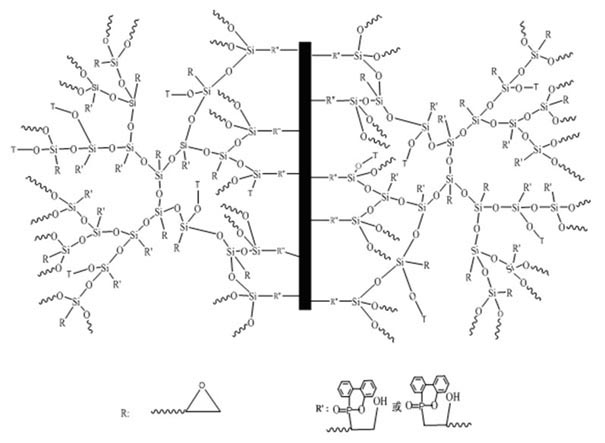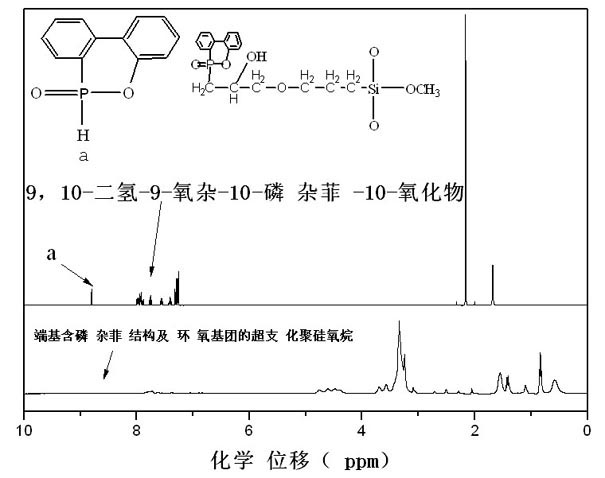Surface modified carbon nanotube and preparation method thereof
A carbon nanotube, surface modification technology, applied in the direction of nanotechnology, nanotechnology, nanotechnology, etc. for materials and surface science, can solve the problems of gel, application limitation, silanol instability, etc., to achieve electrical properties Low impact, high flame retardant efficiency, improved flame retardant effect
- Summary
- Abstract
- Description
- Claims
- Application Information
AI Technical Summary
Problems solved by technology
Method used
Image
Examples
Embodiment 1
[0034] 1. Synthesis of hyperbranched polysiloxane containing phosphaphenanthrene structure and epoxy group
[0035] Take 4.0g of distilled water and 47.3g of 3-glycidyloxypropyltrimethoxysilane and mix evenly, then slowly add 1mL of HCl with a concentration of 36.5% drop by drop at room temperature and under stirring; React for 4 hours; after the reaction is complete, vacuum-dry to obtain transparent and viscous hyperbranched polysiloxane containing epoxy groups.
[0036] Get 20g of the above-mentioned hyperbranched polysiloxane containing epoxy groups, 7.5g 9,10-dihydro-9-oxa-10-phosphaphenanthrene-10-oxide and 120mL n-propanol, mix well, add three Phenyl phosphorus 0.3g, heat up to 99°C, keep warm for 5 hours, distill under reduced pressure to obtain a light yellow liquid, add 10g of hexamethyldisiloxane and 0.8g deionized water to 10g of the above light yellow liquid and mix, heat to 72°C constant temperature reaction for 6 hours. After purification, filtration, vacuum di...
Embodiment 2
[0055] 1. Synthesis of phosphorus-containing phenanthrene structure and epoxy-based hyperbranched polysiloxane
[0056] Take 5.8g of distilled water and 47.3g of 3-glycidyloxypropyltrimethoxysilane and mix evenly, then slowly add 1mL of 33.5% H 2 SO 4 After the dropwise addition, the temperature was raised to 55° C. to continue the reaction for 4 hours; after the reaction was completed, vacuum drying was carried out to obtain a transparent and viscous hyperbranched polysiloxane containing epoxy groups.
[0057] Take 20g of the above-mentioned epoxy-containing hyperbranched polysiloxane, mix 7.5g 9,10-dihydro-9-oxa-10-phosphaphenanthrene-10-oxide with 120mL propanol, add triphenyl Base phosphorus 0.3g, heat up to 99°C, keep warm for 10 hours, distill under reduced pressure, then purify, filter, and distill under reduced pressure to obtain a light yellow liquid; add 20g of hexamethyldisiloxane and 2g of deionized water 20 g of the above light yellow liquid was mixed, hea...
Embodiment 3
[0064] 1. Synthesis of phosphorus-containing phenanthrene structure and epoxy-based hyperbranched polysiloxane
[0065] Take 4.7g of distilled water and 23.6g of 3-glycidyloxypropyltrimethoxysilane and mix evenly, then slowly add 1mL of HCl with a concentration of 36.5% dropwise at room temperature and under stirring; React for 4 hours; after the reaction is complete, vacuum-dry to obtain transparent and viscous hyperbranched polysiloxane containing epoxy groups.
[0066]Take 20g of the above-mentioned hyperbranched polysiloxane containing epoxy groups, mix 7.5g 9,10-dihydro-9-oxa-10-phosphaphenanthrene-10-oxide with 120mL methanol, add triphenyl Phosphorus 0.6g, heat up to 95°C, keep warm for 8 hours, distill under reduced pressure to obtain a light yellow liquid; add 20g of hexamethyldisiloxane and 2g of deionized water to 20g of the above light yellow liquid and mix, heat to 78°C The reaction was carried out for 10 hours to obtain the crude product. Dissolve the crude pro...
PUM
 Login to View More
Login to View More Abstract
Description
Claims
Application Information
 Login to View More
Login to View More - R&D
- Intellectual Property
- Life Sciences
- Materials
- Tech Scout
- Unparalleled Data Quality
- Higher Quality Content
- 60% Fewer Hallucinations
Browse by: Latest US Patents, China's latest patents, Technical Efficacy Thesaurus, Application Domain, Technology Topic, Popular Technical Reports.
© 2025 PatSnap. All rights reserved.Legal|Privacy policy|Modern Slavery Act Transparency Statement|Sitemap|About US| Contact US: help@patsnap.com



